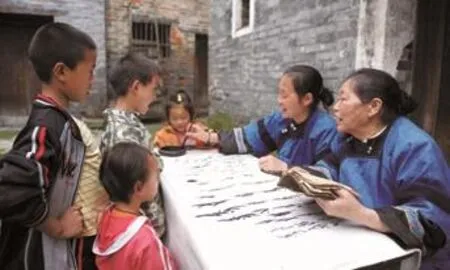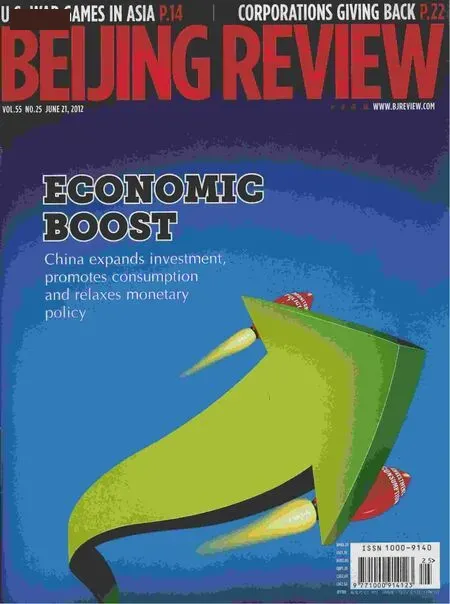Women Words
By Yuan Yuan
Women Words
By Yuan Yuan
A mysterious ancient language struggles for its survival

LI GA
Jiangyong County, a remote place in central China’s Hunan Province, has been gathering more attention due to a strange-looking language passed down exclusively by women for hundreds of years.
The language, which is called nushu, or women’s script, is said to originate from Chinese square-block characters, but the orthography and pronunciation are quite different from all other branches of Chinese dialects.
“Women in ancient days couldn’t get the chance to go to school. So the wise women in Jiangyong created their own language,” said Zhao Liming, a professor at the Department of Chinese Language and Culture of Tsinghua University. Zhao has been studying nushu for more than 30 years.
“Only women could understand the language and they write and talk with the language. Although most of them spent their entire lives doing housework, with this language, they could manage to communicate in a unique way.”
According to Zhao, nushu is the only single-sex writing system in the world, but its origin is still not clear. The earliest record is on coins minted by rebel farmers between 1851 and 1864. Experts believe this language was developed in the Jin Dynasty (1150-1234).
“According to local customs, when a woman passes away, all the nushu written records the woman once held should be burned,” Zhao said. “That is why it is very hard to fnd records of this language and it has not been known by people from other places for a long time.”
A novel find
Zhou Shuoyi, a native to Jiangyong, started his study on nushu in the 1950s. Zhou’s family had a poem written in nushu, which had been handed down for at least six generations. His father was very interested in the strange writing and urged Zhou to investigate.
一般认为,美国是资本相对丰富,而劳动相对稀缺的国家,理应出口资本密集型商品,而进口劳动密集型商品。但Leontief(1953)运用投入产出法,对美国经济数据进行验证,却发现发现美国进口的是资本密集型产品,而出口的却是劳动密集型产品,与H-O理论的预测不相符合,这个研究结果后来通常被称为“里昂惕夫之谜”。Leontief经过分析认为,这种现象可能是由于美国工人的劳动效率比其他国家工人更高所造成的。但这个观点通常不被人们接受。
In 1982, Zhou wrote a book about the region’s culture, including a section on nushu. After its publication, scholars from home and abroad started dropping by. Gong Zhebing, a professor of philosophy at Wuhan University in neighboring Hubei Province is one of them.
Gong’s essay, Investigation on a Special Language, was published on the Journal of South-Central Institute for Nationalities in early 1983. It is the frst essay on nushu.
In 1997, Gong founded the China Women and Gender Research Center at Wuhan University, which then developed into one of the most authoritative study centers on nushu.
Professor Zhao at Tsinghua University started her research on nushu in the 1980s. Since the 1990s, she has guided a number of graduate students in studying nushu at Tsinghua. “So far, we have collected a vocabulary of 1,500 words,” said Zhao, who compiled them into a dictionary with students in 2005.
“Nushu is rendered in a style much more cursive than written Chinese and the characters are thinner than Chinese characters,”Zhao said. “It is written from top to bottom in columns. Women write nushu on fans, handkerchieves or cloth with sharpened sticks and soot from the bottom of a pot.”
Zhao attributes the emergence of nushu in Jiangyong partly to the region’s ancient custom of “sworn sisters,” whereby village girls would pledge one another fealty and friendship forever. The tight sorority, which included growing up together in cobbled village lanes and gathering with adult women to weave and embroider, was inevitably shattered when the time for marriage came. Tradition dictated that a bride goes away to her groom’s home—and that is where nushu came in.
“The content of the written record of nushuis mostly about the sorrow and wishes expressed among sworn sisters,” said Zhao, who gave an example of the Third Day Book.
In 1990, Zhao visited Yang Huanyi, who was then 81 years old and was the only known genuine nushu speaker left in Jiangyong.
“Nushu is spread mostly among rural women who had their feet bound to a tiny size,” Zhao said.
Yang started to read and write nushu as a little girl with her seven sworn sisters. Yang watched nushu’s wax and wane in the past century, and would even write nushu on her knees, as only men were allowed to write on tables.
On September 20, 2004, Yang passed away. Unfortunately, none of Yang’s children and grandchildren inherited her profciency in this unique language.
Experts said that Yang’s death marked the end to the tradition in which women shared their innermost feelings with female friends through a set of codes incomprehensible to men.
Inheritance
Local authorities in the late 1990s started to attach importance to nushu’s cultural value and tourism potential. In 2000, a free nushu training school was set up in Puwei Village in Jiangyong for women learning the language in their spare time.
With a total population of around 200 people, Puwei is one of the most famous villages for nushu culture. In 2004, the Nushu Museum was founded in the village, where visitors and villagers can take nushu classes. Meanwhile, tourists can also enjoy the unique female social life and cultural ecology.
Hu Meiyue, 42 years old, visits the museum every Saturday to teach nushu to any village girls who show up. Hu is the granddaughter of Gao Yinxian, another genuine nushu speaker who passed away in 1990. “I found some fowery-looking characters in my grandmother’s handkerchieves at my childhood and asked her to tell me what they were,” said Hu, who never thought she could make a living by teaching the fowery-looking characters. “It is a pity that I couldn’t learn more from my grandmother as she couldn’t teach at all due to her bad health in her later years.”

YOUNGER FANS: He Jinghua and her daughter Pu Lijuan demonstrate nushu writing to children in Jiangyong County
Another teacher at the Nushu Museum, Pu Lijuan, learns nushu with her mother, 78-year-old He Jinghua, who set up a nushu training school in 2004 in her own house in Puwei. He said that it was her responsibility to pass down the unique language to younger generations.
On April 19, 2012, at a cultural exhibition in New York City on the Third UN Chinese Language Day, He and Pu wrote down the unique feminine script on handkerchiefs, chanted out the written contents and fascinated the audience.
The Jiangyong County Government established a nushu certifcation process in 2003 and offered a subsidy of 100 yuan ($16) per month to those who qualify. Of the seven living people who have earned the certificate, 24-year-old Hu Xin is the youngest.
Hu first studied nushu with her mother in 2000, when her mother attended the free training school in Puwei. After graduating from a technical secondary school in 2007, Hu came back to her hometown. With a strong interest in nushu, she started to work at the Nushu Museum as a ticket collector. In 2008, she became a guide and teacher after receiving intensive training. Hu was invited to demonstrate the calligraphy of nushu at the China Pavilion of the World Expo in Shanghai in 2010.
In 2011, Snow Flower and the Secret Fan, a historical drama film based on the novel of the same name by the Chinese-American author Lisa See, was released worldwide. It is about the friendship of two sworn sisters in the 19th century. The heroines express themselves by writing in nushu on paper fans. It is the frst time for nushu to be shown in a flm.
“But nushu still faces a big challenge,”said Xiao Ping, a village official in Puwei.“There is just a small handful of people who can read and write nushu. Most people don’t have the interest in learning it at all, especially young people.”
Hu admitted that nobody else of her age was willing to spend time studying nushu, which she said helps little to fnd jobs or earn money. “Almost all the young people went to big cities to work,” she said.
“The subsidy of 100 yuan per month is far from enough to make a living,” said Pu, who suggests making and selling souvenirs with printed or embroidered nushu. “Efforts should be made to let more people know it.
yuanyuan@bjreview.com

